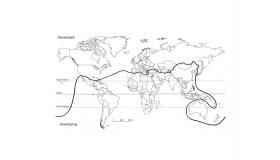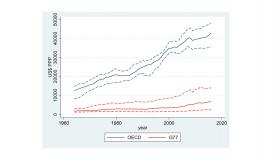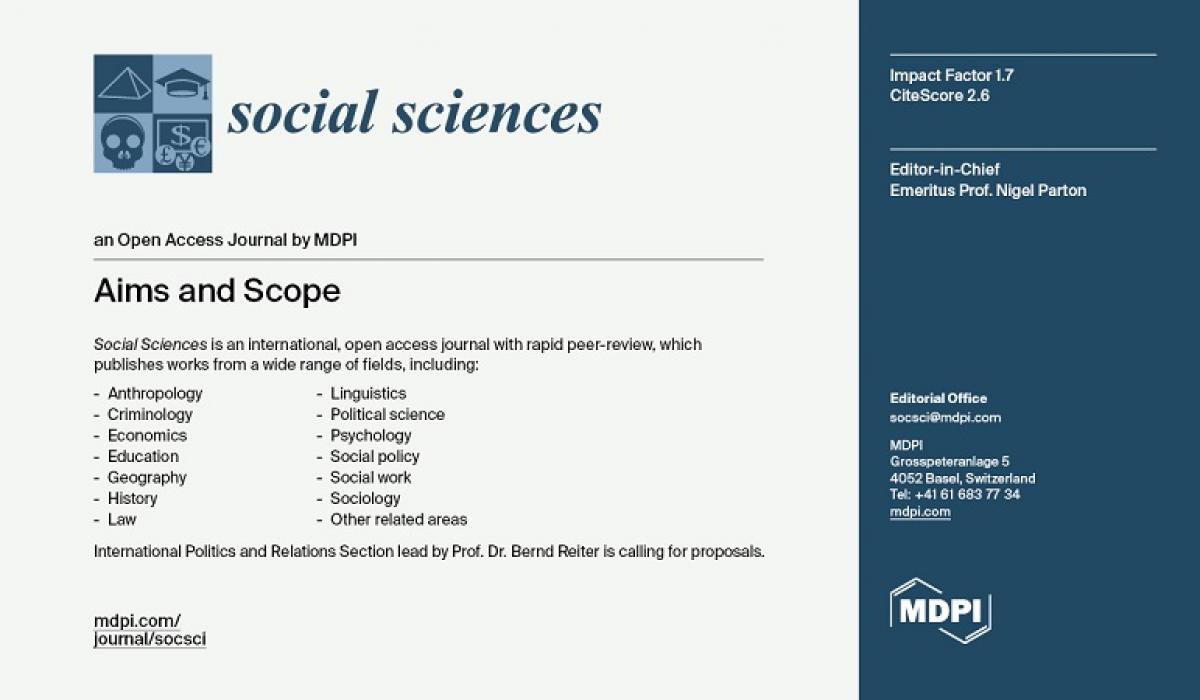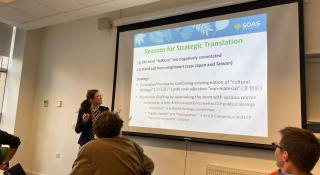
Breadcrumbs navigation
The Brandt Line after forty years: The more North–South relations change, the more they stay the same?
Nicholas Lees discusses his new article published in BISA journal Review of International Studies. The article assesses whether, forty years after the popularisation of the Brandt Line, the global South has lost its distinctiveness and coherence relative to the North since 1980.
The Brandt Line is a way of visualising the world that highlights the disparities and inequalities between the wealthy North and the poorer global South. It was popularised in 1980 through North-South: A Programme for Survival, a report addressing the problems of international inequality written by a committee led by the former German chancellor, Willy Brandt. The report proposed a set of policies to address problems of global inequality and poverty, and to overcome the political tensions that had emerged between the wealthy, industrialised North and the less economically developed (or underdeveloped) global South. The report included a map of the world divided into North and South by the ‘Brandt Line’, which became one of the most recognisable and influential ways of representing the economic and political divisions of world politics. Many of us probably remember maps featuring the Brandt Line from school geography textbooks. Given that decades have passed since the publication of North-South, it is important to ask whether the Brandt Line is still relevant. A lot has happened in the intervening period: the global turn from central planning to markets, the era of US unipolarity, global economic integration, the War on Terror and the global financial crisis. Do the same economic and political divisions between the North and the global South persist, or have they changed beyond recognition? The fortieth anniversary of the Brandt Report provides an opportunity for reassessment.

The Brandt Line. Photo by Jovan.gec on Wikimedia Commons.
I examined both economic inequalities and patterns of dissatisfaction among states to evaluate whether the North-South divide still exists. To do this I categorised states as belonging to the global South if they were a member of the Group of 77 in the United Nations in 1980, and as belonging to the North if they were members of the Organisation for Economic Co-operation and Development (OECD) in the same year. States seem to regard these groups as mutually exclusive: both Mexico and South Korea left the G77 when they joined the OECD.

Median real incomes among countries of the North and global South, with interquartile ranges dashed. A categorical gap persists. Data from the Maddison Project.
Economic inequality and economic power
Every decade seems to bring with it a new set of arguments that the North-South divide is no longer relevant, or that its irrelevance is imminent. A perennial claim is that the global South is a transitory category because less economically developed societies should experience ‘catch-up growth’ and move towards the income levels of earlier waves of industrialisers. Some have claimed that catch-up growth is conditional on adopting the right policies, implying that the South will separate into different strata based on policy choices. But evidence for catch-up growth as a general pattern has been elusive and the debate among economists continues. Another wave of research in political economy and sociology investigated whether globalisation was decreasing or increasing inequality worldwide. The findings of this research tended to be quite nuanced: rising within-nation inequality might have offset falling international inequality, with the ‘lower South’ catching up with the middle income ‘upper South’ rather than the South catching up with the North as a whole.
To evaluate the relevance of the Brandt Line I wanted to use measures that are most relevant to questions about political divisions between North and South. Much of the research into global inequality has been conducted by economists and sociologists, who have framed these questions in particular ways. For example, asking questions about the absolute incomes of individuals across the world makes sense if we are focused on economic welfare or if we are conceiving the world as one global society. But from a political perspective, relative incomes and the share of economic power between different societies might be more significant. Additionally, it matters a great deal for international politics that societies are organised as independent, sovereign political entities. Therefore it is the inequalities of relative income and economic power between sovereign states that my research focuses on.
To evaluate whether North and South persist, I used data from the Maddison Project on real incomes across the world and World Bank data on Gross Domestic Product (GDP) at market exchange rates. I found that growth rates were on average lower across the South than the North and that the absolute average income gap between the North and South grew. Ranking the states composing the North and the South by income in 1980 and 2015 reveals very strong continuities: very few states in the global South overtook any of the states in the North. Indeed, by 2016 the state at the 75th percentile of incomes in the South had only achieved the level of income of the state at the 25th percentile for the North in 1972. So even the state richer than three quarters of the rest of the South in 2016 had not yet reached the income level the majority of Northern states enjoyed in 1980. The pattern appears to be one of churn within the global South. If we imagine the states of the world as a deck of cards, ordered in terms of income, with states of the North and the global South represented by cards of different suits, then it is as if the cards have been shuffled somewhat within their suits, but the suits themselves have not been shuffled together. This corresponds with the finding that diversity in terms of income levels within the global South has increased, with formerly low income states in Asia and regional overperformers in Africa moving up the income rankings, leaving behind states that have suffered from civil war and instability.

Social Sciences is an international, open access journal with rapid peer-review, which publishes works from a wide range of fields, including anthropology, criminology, economics, education, geography, history, law, linguistics, political science, psychology, social policy, social work, sociology and so on. Social Sciences is published monthly online by MDPI.
A slightly different picture emerges if we examine economic power, which was measured using GDP at market exchange rates to try to capture the size of a state’s domestic market, recognised as a key source of leverage in international negotiations. China’s staggering rise becomes apparent in this analysis: its share of the world economy rose ten-fold since 1980. The rising economic power of the rest of the global South has been less dramatic but still notable: in 1980 the GDP of the OECD was around four and a half times greater than the whole of the South, four decades later it was around two and a half times greater. Nonetheless, the OECD states retain greater aggregate economic power than China and the whole of the rest of the global South combined, despite their falling share of world output over time.
It seems therefore that North-South income inequality has persisted whilst economic power has shifted, with diversity in the South growing somewhat.
A dissatisfied South?
The combination of persistent relative income inequality and shifting economic power raises a puzzle: has economic growth mollified the more successful developers of the global South, or has their rising share of economic power given them greater opportunity to press their grievances against the North? On the one hand, successful participation in the world economy might reduce the dissatisfaction of states. On the other, the remaining inequalities of a world order in which the US remains hegemonic might be a source of dissatisfaction. These questions are central to recent debates over the changing role of the BRICS (Brazil, Russia, India, China and South Africa) and other emerging economies in world politics. Some scholars have seen the emerging powers as abandoning the rest of the global South in order to establish themselves as new greater powers, whilst other scholars have argued that they continue to share a common perspective and stand in solidarity with the rest of the G77.
To provide additional insights into which of these tendencies has prevailed in the decades since the Brandt Line was drawn, I drew on data from Bailey, Strezhnev and Voeten1, who have created a measure of the policy preferences of states based on voting behaviour at the UN. Their measure of state’s policy positions can be interpreted as reflecting a state’s satisfaction with the US-led international order. I analysed the patterns in this data since 1980 to assess whether political divides between the North and the global South have persisted, and whether the South is still coherent or whether its component states have gone their separate ways and abandoned a common political platform.
My analysis found no evidence that the states of the South are more satisfied with the international order than in 1980 and no evidence that the political gap between the North and the global South has decreased. There is also no evidence that the South is less coherent than the North in its stance on global issues, or that it has become less coherent over time. The findings are consistent with the somewhat neglected finding of Keisuke Iida that the solidarity of the global South at the UN increased markedly from the 1970s into the 1980s2. The rise of the emerging powers has not changed this pattern: I show that there is no quantitative evidence that the preferences and priorities of Brazil, China, India and South Africa have departed from those of the states making up the rest of the G77 in recent years.
In terms of political disagreement and levels of satisfaction with the prevailing international order, the Brandt Line seems very much intact after four decades.
What can this combination of findings tell us about the relationship between the North and the global South four decades after the popularisation of the Brandt Line? Overall, my investigation found more in the way of continuity than change. The global South has diversified, but hierarchies of income level remain in place. Most notable, however, is the combination of the South’s rising economic power combined with persistent dissatisfaction with the US-led international order. Much has been said about the rise of China and the looming power transition with the US, but there is also a much broader diffusion of economic power underway. Yet economic growth has not decreased the apparent dissatisfaction of either the emerging economies or the rest of the global South.
As power transition theory within international relations would suggest, the rising ability to effect change in the hands of those states that have been persistently dissatisfied with the international order points to instability in world politics, and deadlock in international institutions. After forty years the problem identified by the Brandt Commission have not gone away — deferred but not resolved. As an academic discipline, international relations can make a contribution by continuing to investigate the divisions and inequalities highlighted by the Brandt Line, which can be investigated fruitfully using a combination of both qualitative and qualitative methods.
1. Michael A Bailey, Strezhnev, Anton, and Voeten, Erik, ‘Estimating Dynamic State Preferences from United Nations Voting Data’, Journal of Conflict Resolution, 61:2 (2017), pp. 430–56.
2. Keisuke Iida, ‘Third World Solidarity: The Group of 77 in the UN General Assembly’, International Organization, 42:2 (1988), pp. 375–95.
You can read the full article at DOI: https://doi.org/10.1017/S026021052000039X
BISA members receive access to RIS (and to our other journal European Journal of International Security) as a benefit of membership. To gain access, log in to your BISA account and scroll down to the 'Membership benefits' section. If you're not yet a member join today.


